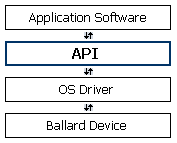|























| |
 | OUR API LIBRARIES ARE:- Easy To Use
- Robust and Flexible
- Supported in many programming languages, including C/C++, C#, VB, VB.net, and LabVIEW™
- Accompanied with comprehensive example programs
|
Application Programming Interface
The Application Programming Interface (API) is a library of functions that relieves the software developer of hardware details and simplifies the development of custom applications. As seen in the figure below, the API is used by a software application to access a Ballard Device for a particular Operating System. API functions include routines for transmitting, receiving, scheduling, recording, data manipulation, error injection, and time-tagging bus messages. BTIDriver™ BTIDriver is the common set of API libraries for most of Ballard Technology's newer hardware products. It includes support for many of the avionics databus interfaces supported by Ballard Technology. BTIDriver unifies the development of applications for Ballard Technology products by keeping a consistent programming interface across products. Programs developed today for one type of BTIDriver compliant product, will be able to operate future BTIDriver compliant products with little or no change to the source code. Code developed for older Ballard devices can be adapted for use with newer BTIDriver compatible devices through a DLL translation driver. Ease Of Use
Ballard products can be easily configured and operated with only a few API calls. The comprehensive libraries also include a broad range of functions for specialized needs.
The API provided with Ballard products is designed to allow the user access to the avionics databuses without the burden of memory maps, data registers, or other low level interfaces. The API is organized by groups of similar high level functions. For example, to handle data and status associated with messages there are functions to configure, read, and write message information. Comprehensive Examples
Complete source code and executable versions of all example programs are provided on the distribution media with the API libraries. The example programs demonstrate databus transmission, reception, monitoring (data logging), error injection, end system simulation, use of engineering units, triggering, and more. These examples demonstrate how to use the API and are also excellent starting points for the development of custom applications.
|
